Published on Tue 31 October 2023 by @lowercase_drm
Understanding the different types of LDAP authentication methods is fundamental to apprehend subjects such as relay attacks or countermeasures. This post introduces them through the lens of Python libraries.
LDAP authentication methods
According to Microsoft, Active Directory supports 3 authentication methods on LDAP connection:
- Simple: Simple username/password as defined in (one of) the LDAP RFC.
- Sicily: This legacy protocol is another protocol to negotiate underlying authentication method. Active Directory only supports NTLM as an authentication protocol with Sicily.
- Simple Authentication and Security Layer (SASL): SASL is a framework for authentication, it allows client and server to negotiate an authentication method among those supported. SASL authentication adds 4 authentication subtypes:
- GSS-SPNEGO: Simple and Protected GSSAPI Negotiation Mechanism, yet another protocol to negotiate authentication. Active Directory provides NTLM or Kerberos as underlaying methods.
- GSSAPI: Kerberos (well, actually, GSSAPI is a lot more than "Kerberos", but in Active Directory environment and to simplify the topic, consider they are the same)
- EXTERNAL: in the SASL framework, EXTERNAL mode is used by the client to tell the server to use information provided outside of what is strictly considered LDAP communications, for example, the GID/UID of the client process if the communication is done through a Unix socket or the TLS client certificate if the connection is done via TLS. Active Directory seems to exclusively use this mode to support TLS authentication via Schannel.
- DIGEST-MD5: This legacy protocol is based on the HTTP Digest Authentication; it is thus a challenge/response authentication protocol. It is required by the LDAPv3 RFC but is now deprecated.
In total, LDAP on Active Directory supports 6 "kinds" of authentication.
Side note: SASL mechanisms supported by the target domain controller can be anonymously requested:
>>> import ldap3
>>> server = ldap3.Server('ldap://kingslanding.sevenkingdoms.local', get_info=ldap3.ALL)
>>> connection = ldap3.Connection(server)
>>> connection.bind()
True
>>> connection.server.info.supported_sasl_mechanisms
['GSSAPI', 'GSS-SPNEGO', 'EXTERNAL', 'DIGEST-MD5']
Protections
The most (in)famous attacks against LDAP authentication are relay attacks, and more precisely NTLM relay. Keep in mind that relaying Kerberos authentication is theoretically possible but not as easy to do in practice and beyond the scope of this blog post. Moreover, authenticating with certificates through Schannel is not impacted by relay attacks because of how it intrinsically works.
Microsoft provides two countermeasures to protect LDAP authentications against relay attacks, as described in KB4520412. Those two protections are LDAP signing and LDAP channel binding.
LDAP Signing
The idea here is to encrypt or sign the LDAP payload with a shared secret between the client and the server. NTLM, Kerberos and DIGEST-MD5 based authentications implement this protection. Unlike what the name suggests, "LDAP signing" protection entails the signing of the LDAP payload, as well as its (optional) encryption, depending on what is negotiated between the client and the server. When signature or encryption is negotiated, it is no longer possible for an attacker to send arbitrary command after the authentication relay.
To enable LDAP signing, Domain controller: LDAP server signing requirements must be set to Require signing within the domain controller policy.
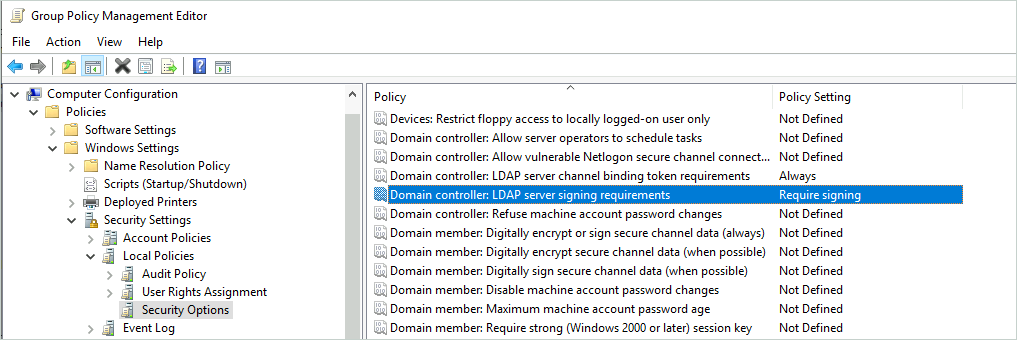
Channel Binding
This protection is designed to prevent relaying authentications to LDAPS. The idea is to bind the outer secure connection (TLS in our case) to application data over an inner client-authenticated channel (NTLM here). More precisely, Active Directory implements 'tls-server-end-point' channel binding Type, the general concept is covered here. This kind of channel binding seems to be the only one supported by Active Directory during NTLM and Kerberos authentications with LDAP. Channel binding during NTLM authentication is performed by adding a new AV_PAIR (attributes/value pair structure defined in MS-NLMP 2.2.2.1) within the AUTHENTICATE_MESSAGE (MS-NLMP 2.2.1.3). This new AV_PAIR has AvId which is 0x000A (MsvAvChannelBindings).

The Value field contains a MD5 hash of a gss_channel_bindings_struct struct which basically is a magic constant concatenated with the SHA256 hash of the server certificate.
Here is an example of the simplified struct represented in pseudo-code:
gss_channel_bindings_struct {
initiator_addrtype: '\x00\x00\x00\x00';
initiator_address: '\x00\x00\x00\x00';
acceptor_addrtype: '\x00\x00\x00\x00';
acceptor_address: '\x00\x00\x00\x00';
application_data: '\x55\x00\x00\x00' + 'tls-server-end-point:' + 'ae2670228880c00ad0448c156575212d1bbdaea7dde68f88a41ff5e084940f92';
# [len(magic+hash)] # [magic] # [hash]
}
Active Directory services use Schannel as Security Service Provider (SSP) to handle TLS. According to the documentation, this SSP only uses the application_data field to perform channel binding.
Regarding Kerberos, instead of being added within the AUTHENTICATE_MESSAGE, the hash is put into the cksum field and then the client adds it to the authenticator.
To require channel binding on LDAP, Domain controller: LDAP server channel binding token requirements must be set to Always within the domain controller policy. Keep in mind that GPO support for LDAP channel binding has been added on March 2020 for all Domain Controllers running at least Windows Server 2008, so be sure to have an up-to-date domain controller (though, if your domain controllers have not been upgraded since March 2020, maybe GPO support for channel binding is not your priority). Microsoft provides a guide to secure LDAP/S services: ADV190023.
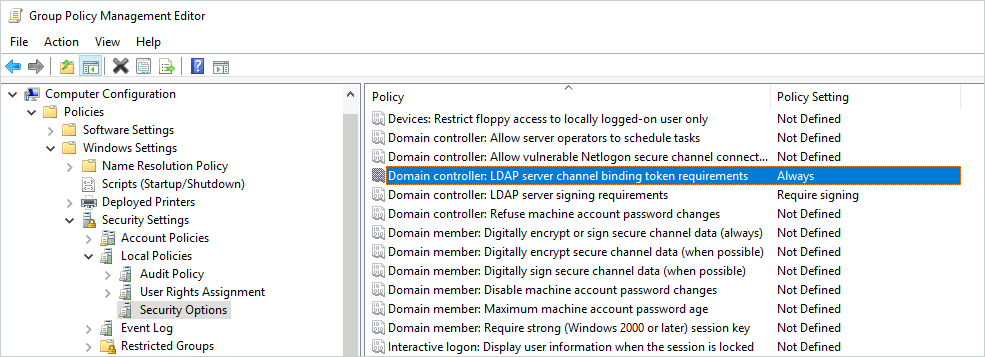
ldap3
The ldap3 library is a pure python implementation of the LDAP 3 RFC and is widely used in offensive tools. It natively supports 5 (sub) authentication methods when used against domain controllers:
- Simple
- Sicily
- SASL (GSSAPI)
- SASL (EXTERNAL)
- SASL (DIGEST-MD5)
But this number decreases if the target domain implements protection.
NTLM authentication
LDAP signing
If Domain controller: LDAP server signing requirements is set to Require signing and a client uses Sicily on LDAP port 389 during the authentication, the following response will be returned by the server:
>>> import ldap3
>>> server = ldap3.Server('ldap://192.168.56.10')
>>> connection = ldap3.Connection(server, authentication=ldap3.NTLM, user='sevenkingdoms.local\\cersei.lannister', password='il0vejaime')
>>> connection.bind()
False
>>> connection.result
{'result': 8, 'description': 'strongerAuthRequired', 'dn': '', 'message': '00002028: LdapErr: DSID-0C090254, comment: The server requires binds to turn on integrity checking if SSL\\TLS are not already active on the connection, data 0, v4f7c\x00', 'referrals': None, 'saslCreds': None, 'type': 'bindResponse'}
The error message is straightforward: the authentication scheme does not provide integrity for communication; thus, the authentication is rejected. Fortunately, user CravateRouge submitted a pull request to the ldap3 project that implements message confidentiality as described within MS-NLMP 3.4.3. With this PR, the DC accepts the connection:
>>> import ldap3
>>> server = ldap3.Server('ldap://kingslanding.sevenkingdoms.local')
>>> connection = ldap3.Connection(server, authentication=ldap3.NTLM, user='sevenkingdoms.local\\cersei.lannister', password='il0vejaime', session_security=ldap3.ENCRYPT)
>>> connection.bind()
True
>>> connection.result
{'result': 0, 'description': 'success', 'dn': '', 'message': '', 'referrals': None, 'saslCreds': None, 'type': 'bindResponse'}
Here is an example of an LDAP PDU containing a whoami response without confidentiality:

The same request with confidentiality enabled:

The pull request implements encryption with Extended Session Security, so the encrypted LDAP PDU is built like this:
[size_of_the_PDU][signature][encrypted_payload]
4 bytes 16 bytes X bytes
| |
| |
| |
_______________| |__________________
| |
| |
[signature_version][checksum][sequence_number]
4 bytes 8 bytes 4 bytes
Where:
signature_versionshould always be1.checksumis the 8 first bytes of the resulting MD5:HMAC_MD5(SIGNING_KEY, CONCAT(SEQUENCE_NUMBER,CLEAR_TEXT_MESSAGE)).SIGNING_KEYis derived from the user's password.sequence_number: number incrementing every time the client sends a message.encrypted_payloadis the cleartext message encrypted with RC4. The key used by this algorithm is also derived from the user's password.
The previous Wireshark screenshot can be interpreted as:
[00000061][01000000][206b9cc72ddf70e0][03000000][c13b.........b67d] [PDU size][version ][ checksum ][seq num ][encrypted payload]
Moreover, the connection is now protected against network sniffing, thus it is possible to create users or computers within the directory as it would be possible with LDAPS (not possible by default on unencrypted connections):
>>> import ldap3, string, random
>>> server = ldap3.Server('ldap://kingslanding.sevenkingdoms.local')
>>> connection = ldap3.Connection(server, authentication=ldap3.NTLM, user='sevenkingdoms.local\\cersei.lannister', password='il0vejaime', session_security=ldap3.ENCRYPT)
>>> connection.bind()
True
>>> new_user_dn = 'CN=%s,%s' % ('newuser', 'OU=Crownlands,DC=sevenkingdoms,DC=local') # sorry for the GoT lore...
>>> new_password = ''.join(random.choice(string.ascii_letters + string.digits + string.punctuation) for _ in range(15))
>>> ucd = {
... 'objectCategory': 'CN=Person,CN=Schema,CN=Configuration,DC=sevenkingdoms,DC=local',
... 'distinguishedName': 'CN=%s,%s' % ('newuser', 'OU=Crownlands,DC=sevenkingdoms,DC=local'),
... 'cn': 'newuser',
... 'sn': 'newuser',
... 'givenName': 'newuser',
... 'displayName': 'newuser',
... 'name': 'newuser',
... 'userAccountControl': 512,
... 'accountExpires': '0',
... 'sAMAccountName': 'newuser',
... 'unicodePwd': '"{}"'.format(new_password).encode('utf-16-le')
... }
>>>
>>> connection.add(new_user_dn, ['top', 'person', 'organizationalPerson', 'user'], ucd)
True
>>> connection.result
{'result': 0, 'description': 'success', 'dn': '', 'message': '', 'referrals': None, 'type': 'addResponse'}
This result is consistent with the Microsoft documentation:
To modify this attribute [the password], the client must have a 128-bit Transport Layer Security (TLS)/Secure Socket Layer (SSL) connection to the server. An encrypted session using SSP-created session keys using Windows New Technology LAN Manager (NTLM) or Kerberos are also acceptable as long as the minimum key length is met.
As an alternative, it is also possible to use LDAPS instead of LDAP. Since the TLS layer provides integrity, LDAP signing is not enforced on LDAPS connections.
Channel Binding
If the domain controller forces channel binding by setting the option LDAP server channel binding token req to Always, the vanilla ldap3 library is not able to authenticate:
>>> import ldap3
>>> server = ldap3.Server('ldaps://kingslanding.sevenkingdoms.local')
>>> connection = ldap3.Connection(server, authentication=ldap3.NTLM, user='sevenkingdoms.local\\cersei.lannister', password='il0vejaime')
>>> connection.bind()
False
>>> connection.result
{'result': 49, 'description': 'invalidCredentials', 'dn': '', 'message': '80090346: LdapErr: DSID-0C0906B0, comment: AcceptSecurityContext error, data 80090346, v4f7c\x00', 'referrals': None, 'saslCreds': None, 'type': 'bindResponse'}
The server returns an invalidCredential error with AcceptSecurityContext error, data 80090346 comment. This behavior is not well documented, but we can extrapolate that this error code means that the channel binding token is wrong according to Microsoft documentation on Digest authentication (see SEC_E_BAD_BINDINGS on this page). Tools such as LdapRelayScan use this technique to determine if channel binding is enforced or not.
Inspired by CravateRouge's work, yours truly submitted a PR to implement channel binding support in ldap3. Thus, the DC now accepts the binding:
>>> import ldap3
>>> server = ldap3.Server('ldaps://kingslanding.sevenkingdoms.local')
>>> connection = ldap3.Connection(server, authentication=ldap3.NTLM, user='sevenkingdoms.local\\cersei.lannister', password='il0vejaime', channel_binding=ldap3.TLS_CHANNEL_BINDING)
>>> connection.bind()
True
>>> connection.result
{'result': 0, 'description': 'success', 'dn': '', 'message': '', 'referrals': None, 'saslCreds': None, 'type': 'bindResponse'}
Now, a new AV_PAIR bears the channel binding token:
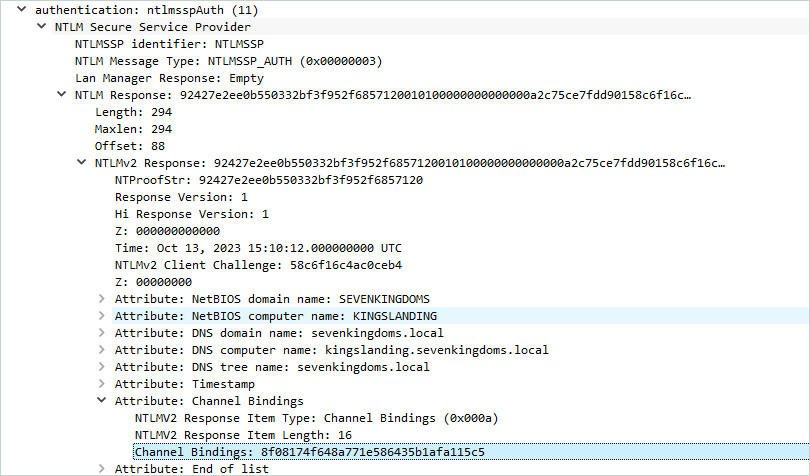
Sending a wrong token raises an authentication error, which shows that the domain controller verifies it on its side too.
Side note: You can easily debug TLS protected connection with ldap3 using the SSLKEYLOGFILE environment variable.
$ export SSLKEYLOGFILE="sslkey.log"
$ python3 my_custom_ldap3_script.py
Then all you need to do is setting the sslkey.log file under the Wireshark menu Edit-> Preferences -> Protocols -> TLS -> (Pre)-Master-Secret log filename.
Keep in mind that both protections (channel binding and LDAP signing) are checked during the bind operation, thus a channel binding bypass can be performed on domain controller with LDAP signing not required.
Side quest: the curious case of NTLM signing
Interestingly, unlike DIGEST-MD5 (see associated section below), it seems that it is not possible to send “signed only” requests when authenticating with Sicily. Indeed, according to Microsoft documentation, NTLM Integrity allows to send a cleartext message and use the signing key to sign it. To enable this feature, the client needs to include the NTLMSSP_NEGOTIATE_SIGN flag within the NEGOTIATE_MESSAGE message sent by the client.
However, during testing, after sending packets like the following, the domain controller systematically returned errors "Unable to decrypt the payload":
[size_of_the_PDU][signature][cleartext_payload]
4 bytes 16 bytes X bytes
It seems that it tries to decrypt the cleartext payload even if the client only sent the NTLMSSP_NEGOTIATE_SIGN flag. It is unclear if "signed only" messages are supported with this authentication method. If you have already done some tests on this topic, feel free to contact us.
Kerberos authentication
All the examples in this section are done after this simple setup:
$ # cd into your impacket venv
$ getST.py sevenkingdoms.local/cersei.lannister:'il0vejaime' -dc-ip kingslanding.sevenkingdoms.local -spn ldap/kingslanding.sevenkingdoms.local
Impacket v0.12.0.dev1+20231015.203043.419e6f24 - Copyright 2023 Fortra
[-] CCache file is not found. Skipping...
[*] Getting TGT for user
[*] Getting ST for user
[*] Saving ticket in cersei.lannister.ccache
$
$ KRB5CCNAME=cersei.lannister.ccache python3
ldap3 is based on python-gssapi to handle Kerberos authentication. This library needs the full hostname in the ccache file's SPN and the realm needs to be in uppercase, otherwise it throws an error. So, the format needs to be ldap/kingslanding.sevenkingdoms.local@SEVENKINGDOMS.LOCAL. For example, ldap/kingslanding@sevenkingdoms.local will not work. However, because the SPN is not encrypted, it is possible to change it in order to be accepted by gssapi. This modification can be done with impacket (see impacket's #1256). Because python-gssapi is a front-end to the system package gssapi, using a TGT is also possible with the same limitation about the format (it needs to be krbtgt/kingslanding.sevenkingdoms.local@SEVENKINGDOMS.LOCAL).
LDAP signing
If LDAP signing is enforced by the domain controller, ldap3 is unable to bind against the DC using the LDAP scheme:
>>> import ldap3
>>> server = ldap3.Server('ldap://kingslanding.sevenkingdoms.local')
>>> # Remember: realm must be in uppercase
>>> connection = ldap3.Connection(server, user='cersei.lannister@SEVENKINGDOMS.LOCAL', authentication = ldap3.SASL, sasl_mechanism=ldap3.KERBEROS)
>>> connection.bind()
False
>>> connection.result
{'result': 8, 'description': 'strongerAuthRequired', 'dn': '', 'message': '00002028: LdapErr: DSID-0C090259, comment: The server requires binds to turn on integrity checking if SSL\\TLS are not already active on the connection, data 0, v4563\x00', 'referrals': None, 'saslCreds': b'', 'type': 'bindResponse'}
Once again, pull request #1042 enhances the capabilities of ldap3 by implementing Kerberos payload encryption:
>>> import ldap3
>>> server = ldap3.Server('ldap://kingslanding.sevenkingdoms.local')
>>> connection = ldap3.Connection(server, user='cersei.lannister@SEVENKINGDOMS.LOCAL', authentication = ldap3.SASL, sasl_mechanism=ldap3.KERBEROS, session_security=ldap3.ENCRYPT)
>>> connection.bind()
True
>>> connection.result
{'result': 0, 'description': 'success', 'dn': '', 'message': '', 'referrals': None, 'saslCreds': b'', 'type': 'bindResponse'}
>>> # Payloads are now encrypted, it is now possible to create computer or user as it would be possible with LDAPS.
Sealed flag is set within the Kerberos context, which means that the payload is now encrypted and signed:

The symmetric key used to encrypt those exchanges is sent by the server in the authenticator part of the AP-REP (keytype 18 usage 22 and 24).
Channel Binding
Regarding channel binding support, python-gssapi is compatible with it, so it is possible to authenticate ldap3 against domain controller with this protection.
>>> import ldap3
>>> server = ldap3.Server('ldaps://kingslanding.sevenkingdoms.local')
>>> connection = ldap3.Connection(server, user='cersei.lannister@SEVENKINGDOMS.LOCAL', authentication = ldap3.SASL, sasl_mechanism=ldap3.KERBEROS)
>>> connection.bind()
True
>>> connection.result
{'result': 0, 'description': 'success', 'dn': '', 'message': '', 'referrals': None, 'saslCreds': b'', 'type': 'bindResponse'}
The channel binding token is sent within the authenticator in the AP-REQ Kerberos message:
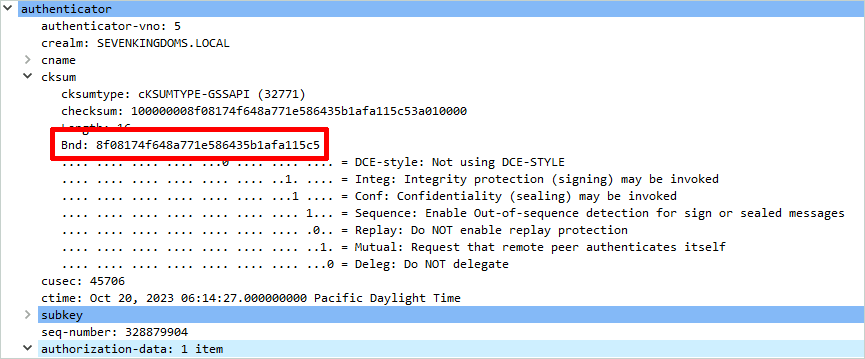
During our tests, we were not able to send a crafted channel binding token without patching the libkrb5-dev low level package. Thus, it is unclear if the domain controller checks it (more on this in the GSS-SPNEGO section).
Side note: You can debug Kerberos protected connections with Wireshark as explained here.
Simple authentication
Simple authentication is a classic user/password authentication, so it is not "vulnerable" to relay attack: if an attacker manages to trick the victim to authenticate against their machine, they don't need to relay the authentication as they got the cleartext password. This authentication method is not compatible with LDAP signing, a strongerAuthRequired error is returned by the server if the client tries to authenticate. However, it turns out that simple authentication is not impacted by channel binding enforcement. Thus, if the attacker has a valid account, its corresponding password (it will not work with the NT hash, so pth attack is not possible), and the DC exposes an LDAPS service, they can use it to query the DC.
>>> server = ldap3.Server('ldaps://192.168.56.10')
>>> connection = ldap3.Connection(server, authentication=ldap3.SIMPLE, user='cersei.lannister@sevenkingdoms.local', password='il0vejaime')
>>> connection.bind()
True
>>> connection.result
{'result': 0, 'description': 'success', 'dn': '', 'message': '', 'referrals': None, 'saslCreds': None, 'type': 'bindResponse'}
DIGEST-MD5 authentication
DIGEST-MD5 is an obsolete authentication mechanism, but it is still supported by Active Directory. It is a challenge/response authentication protocol, so it works with a shared secret between the client and the server. According to the RFC, the shared secret is based on the following elements:
a0 = MD5(username-value + ":" + realm-value + ":" + password)
However, as Active Directory does not store the password in a reversible form (unless this behavior is explicitly enabled through GPO/registry), we can ask ourselves how it is possible to compute a0 without knowing the cleartext password.
$ echo -n 'cersei.lannister:sevenkingdoms.local:il0vejaime' | md5sum
532062350b784ce18e7680a2447f6fa1 -
$ echo -n 'CERSEI.LANNISTER:SEVENKINGDOMS.LOCAL:il0vejaime' | md5sum
f39ea5d591925fa63047235f63927a71 -
Turns out that Active Directory stores 29 MD5 hashes which represent various formats of this information. DSIntenals can retrieve those hashes:
PS C:\Windows\system32> Get-ADReplAccount -SamAccountName cersei.lannister -Server sevenkingdoms.local
DistinguishedName: CN=cersei.lannister,OU=Crownlands,DC=sevenkingdoms,DC=local
Sid: S-1-5-21-3990748329-3747950281-3952183803-1115
Guid: 2090a2ab-aeb5-4770-8b9c-de268cb2fc7b
SamAccountName: cersei.lannister
[...]
Owner: S-1-5-21-3990748329-3747950281-3952183803-512
Secrets
NTHash: c247f62516b53893c7addcf8c349954b
[...]
SupplementalCredentials:
[...]
WDigest:
Hash 01: ae9746cdc9ab4c98389c931240bfef49
Hash 02: d134ad87efe27cb920f7261c716e071e
Hash 03: 2cf4c83f64539f3379e14bbc6bb62f7a
Hash 04: ae9746cdc9ab4c98389c931240bfef49
Hash 05: d134ad87efe27cb920f7261c716e071e
Hash 06: ee1f53e170afc2923c76ca1608e24a7c
Hash 07: ae9746cdc9ab4c98389c931240bfef49
Hash 08: 532062350b784ce18e7680a2447f6fa1
Hash 09: 532062350b784ce18e7680a2447f6fa1
Hash 10: f39ea5d591925fa63047235f63927a71
Hash 11: 637e50611556b02b161e139f6721df9a
Hash 12: 532062350b784ce18e7680a2447f6fa1
Hash 13: a89bf491596edce803f45c0fe8b85c2d
Hash 14: 637e50611556b02b161e139f6721df9a
Hash 15: 6228c58f5f6bb52c8d292aedc6747ce2
Hash 16: 6228c58f5f6bb52c8d292aedc6747ce2
Hash 17: 633a4bbaf44681cc7c476633044f965a
Hash 18: f2df7fedf3c221c684f98119dd1d143b
Hash 19: 342b3287424f1021b1efc474694b69c4
Hash 20: d386808d89c8360df3746b66ee3e3b46
Hash 21: 8cf3aecb2eae565c0e91088f1168a753
Hash 22: 8cf3aecb2eae565c0e91088f1168a753
Hash 23: e80735b18be0aeec5ed4cd330ac9e1d3
Hash 24: 894cc33e043d29a258037531fb1af135
Hash 25: 894cc33e043d29a258037531fb1af135
Hash 26: d1f74dbf597d85638150322df881678b
Hash 27: 3214f15a66cb313eb40d94582caaacd4
Hash 28: 51fdf783ee508745d0472b36d6e89033
Hash 29: 4f3bba9380e6e3ad7297608c91fa99dc
[...]
LDAP signing
According to the RFC, DIGEST-MD5 can negotiate signing and encryption during the authentication phase. Active Directory also supports encryption and signature with DIGEST-MD5: when initiating a SASL DIGEST-MD5 authentication the server returns qop="auth,auth-int,auth-conf" which means:
qop-options: A quoted string of one or more tokens indicating the "quality of protection" values supported by the server. The value "auth" indicates authentication; the value "auth-int" indicates authentication with integrity protection; the value "auth-conf" indicates authentication with integrity protection and encryption.
Vanilla ldap3 supports signature with DIGEST-MD5 and can be used to circumvent the lack of NTLM signing support.
>>> import ldap3
>>> server = ldap3.Server('ldap://kingslanding.sevenkingdoms.local') # You cannot use an IP address here, must be a FQDN with a LDAP SPN registred
>>> connection = ldap3.Connection(server, authentication = ldap3.SASL, sasl_mechanism = ldap3.DIGEST_MD5, sasl_credentials = (None, 'cersei.lannister', 'il0vejaime', None, None))
>>> connection.bind()
False
>>> connection.result
{'result': 8, 'description': 'strongerAuthRequired', 'dn': '', 'message': '00002028: LdapErr: DSID-0C090254, comment: The server requires binds to turn on integrity checking if SSL\\TLS are not already active on the connection, data 0, v4f7c\x00', 'referrals': None, 'saslCreds': b'rspauth=5f33da03b10aa1b509ea9d71758279b5', 'type': 'bindResponse'}
>>> # LDAP signing is enabled on the server and ldap3's DIGEST-MD5 implementation supports it
>>> connection = ldap3.Connection(server, authentication = ldap3.SASL, sasl_mechanism = ldap3.DIGEST_MD5, sasl_credentials = (None, 'cersei.lannister', 'il0vejaime', None, 'sign'))
>>> connection.bind()
True
>>> connection.result
{'result': 0, 'description': 'success', 'dn': '', 'message': '', 'referrals': None, 'saslCreds': b'rspauth=f71443de6af69750719e03445bf9ff03', 'type': 'bindResponse'}
Pull request #1042 also implements encryption for DIGEST-MD5.
>>> import ldap3
>>> server = ldap3.Server('ldap://kingslanding.sevenkingdoms.local')
>>> connection = ldap3.Connection(server, authentication = ldap3.SASL, sasl_mechanism = ldap3.DIGEST_MD5, sasl_credentials = (None, 'cersei.lannister', 'il0vejaime', None, 'ENCRYPT'))
>>> connection.bind()
True
>>> connection.result
{'result': 0, 'description': 'success', 'dn': '', 'message': '', 'referrals': None, 'saslCreds': b'rspauth=7a9f565a4f9bf185c9eb7927bf6621ed', 'type': 'bindResponse'}
>>> # Payloads are now encrypted, it is now possible to create computer or user as it would be possible with LDAPS.
Below, a signed whoami response:

The same response encrypted:

The format of the LDAP PDUs with DIGEST-MD5 confidentiality/integrity is similar to those with NTLM confidentiality:
[size_of_the_PDU][encrypted or cleartext payload][checksum][signature_version][sequence_number]
4 bytes X bytes 10 bytes 2 bytes 4 bytes
Channel Binding
The drawback of using DIGEST-MD5 is the lack of channel binding support (even if an IETF draft exists):
>>> import ldap3
>>> server = ldap3.Server('ldaps://kingslanding.sevenkingdoms.local')
>>> connection = ldap3.Connection(server, authentication = ldap3.SASL, sasl_mechanism = ldap3.DIGEST_MD5, sasl_credentials = (None, 'cersei.lannister', 'il0vejaime', None, None))
>>> connection.bind()
False
>>> connection.result
{'result': 49, 'description': 'invalidCredentials', 'dn': '', 'message': '80090346: LdapErr: DSID-0C09058A, comment: AcceptSecurityContext error, data 80090346, v4563\x00', 'referrals': None, 'saslCreds': None, 'type': 'bindResponse'}
Schannel authentication
Another interesting mode is Schannel: it relies on TLS so it is, by design, not subject to channel binding, as the authentication is borne by TLS itself.
>>> import ldap3, ssl
>>> tls = ldap3.Tls(local_private_key_file='jaime.key', local_certificate_file='jaime.crt', validate=ssl.CERT_NONE)
>>> server = ldap3.Server('ldaps://kingslanding.sevenkingdoms.local', tls=tls)
>>> connection = ldap3.Connection(server)
>>> connection.open()
>>> print(connection.extend.standard.who_am_i())
u:SEVENKINGDOMS\jaime.lannister
Schannel is not subject to LDAP signing either as the bind is performed after a StartTLS command when used on the LDAP TCP port.
>>> import ldap3, ssl
>>> tls = ldap3.Tls(local_private_key_file='jaime.key', local_certificate_file='jaime.crt', validate=ssl.CERT_NONE)
>>> server = ldap3.Server('ldap://kingslanding.sevenkingdoms.local', tls=tls)
>>> connection = ldap3.Connection(server, authentication=ldap3.SASL, sasl_mechanism=ldap3.EXTERNAL)
>>> connection.open()
>>> connection.start_tls()
True
>>> connection.bind()
True
>>> connection.result
{'result': 0, 'description': 'success', 'dn': '', 'message': '', 'referrals': None, 'saslCreds': None, 'type': 'bindResponse'}
PassTheCert and Certipy use this authentication mechanism to perform various attacks.
impacket.ldap
The impacket library also implements the LDAP RFC, however, its implementation is minimalistic and not as powerful as ldap3 (developers urge users to use third party libraries for more complex use cases).
Based on our experience, the main limitations of impacket.ldap are related to bad Unicode handling ("Utilisateurs du Bureau à distance" 🥖🇫🇷) and bugs when using complex search filters containing special characters (if your DN is like CN=John Doe (admin account) for example). However, it is still used by some of impacket' scripts and according to the code, impacket.ldap supports 4 (sub) authentication methods:
- Simple
- Sicily
- SASL (GSS-SPNEGO NTLM)
- SASL (GSS-SPNEGO Kerberos)
Impacket's Sicily implementation does not support LDAP signing nor channel binding.
GSS-SPNEGO NTLM
To sum up, GSS-SPNEGO NTLM encapsulates the NTLM protocol within a SASL structure, so it is pretty similar to Sicily authentication. As confidentiality, integrity and channel binding are not implemented within impacket.ldap, this library will not work against hardened domain controllers. However, it seems easy to implement them as impacket implements a lot of NTLM features.
>>> from impacket.ldap import ldap, ldapasn1
>>> ldap_connection = ldap.LDAPConnection('ldap://kingslanding.sevenkingdoms.local', 'dc=sevenkingdoms,dc=local', '192.168.56.10')
>>> ldap_connection.login('cersei.lannister', 'il0vejaime', 'sevenkingdoms.local', '', '', authenticationChoice="sasl")
Traceback (most recent call last):
File "<stdin>", line 1, in <module>
File "/home/user/impacket/impacket/ldap/ldap.py", line 369, in login
raise LDAPSessionError(
impacket.ldap.ldap.LDAPSessionError: Error in bindRequest -> strongerAuthRequired: 00002028: LdapErr: DSID-0C090259, comment: The server requires binds to turn on integrity checking if SSL\TLS are not already active on the connection, data 0, v4563
>>>
>>> # impacket.ldap does not implement NTLM confidentiality, now let's try with channel binding
>>>
>>> ldap_connection = ldap.LDAPConnection('ldaps://kingslanding.sevenkingdoms.local', 'dc=sevenkingdoms,dc=local', '192.168.56.10')
>>> ldap_connection.login('cersei.lannister', 'il0vejaime', 'sevenkingdoms.local', '', '', authenticationChoice="sasl")
Traceback (most recent call last):
File "<stdin>", line 1, in <module>
File "/home/user/impacket/impacket/ldap/ldap.py", line 369, in login
raise LDAPSessionError(
impacket.ldap.ldap.LDAPSessionError: Error in bindRequest -> invalidCredentials: 80090346: LdapErr: DSID-0C09058A, comment: AcceptSecurityContext error, data 80090346, v4563
GSS-SPNEGO Kerberos
As mentioned before, it is not clear if Kerberos authentication is impacted by channel binding with GSSAPI. However, we can state that, it is possible to query a hardened domain controller with impacket's ldap even if channel binding is enforced on LDAPS:
>>> from impacket.ldap import ldap, ldapasn1
>>> ldap_connection = ldap.LDAPConnection('ldap://kingslanding.sevenkingdoms.local', 'dc=sevenkingdoms,dc=local', '192.168.56.10')
>>> ldap_connection.kerberosLogin('cersei.lannister', 'il0vejaime', 'sevenkingdoms.local', '', '')
Traceback (most recent call last):
File "<stdin>", line 1, in <module>
File "/home/user/impacket/impacket/ldap/ldap.py", line 252, in kerberosLogin
raise LDAPSessionError(
impacket.ldap.ldap.LDAPSessionError: Error in bindRequest -> strongerAuthRequired: 00002028: LdapErr: DSID-0C090259, comment: The server requires binds to turn on integrity checking if SSL\TLS are not already active on the connection, data 0, v4563
>>>
>>> # impacket.ldap does not implement Kerberos confidentiality, now let's try with channel binding
>>>
>>> dap_connection = ldap.LDAPConnection('ldaps://kingslanding.sevenkingdoms.local', 'dc=sevenkingdoms,dc=local', '192.168.56.10')
>>> ldap_connection.kerberosLogin('cersei.lannister', 'il0vejaime', 'sevenkingdoms.local', '', '')
True
>>> attributes=list()
>>> paged_search_control = ldapasn1.SimplePagedResultsControl(criticality=True,size=10)
>>> search_filter = '(&(objectCategory=group)(name=Domain Admins))'
>>> search_results = ldap_connection.search(searchFilter=search_filter,searchControls=[paged_search_control],attributes=attributes)
The channel binding token is not present within the authenticator part of the AP-REQ, however the bind request is accepted:
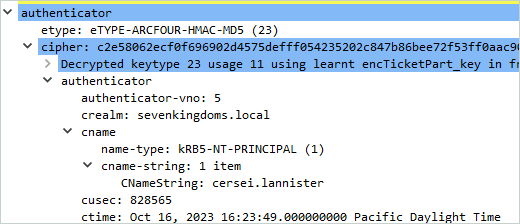
If the token sent by the client is wrong, the bind request fails with the error code AcceptSecurityContext error, data 80090346:
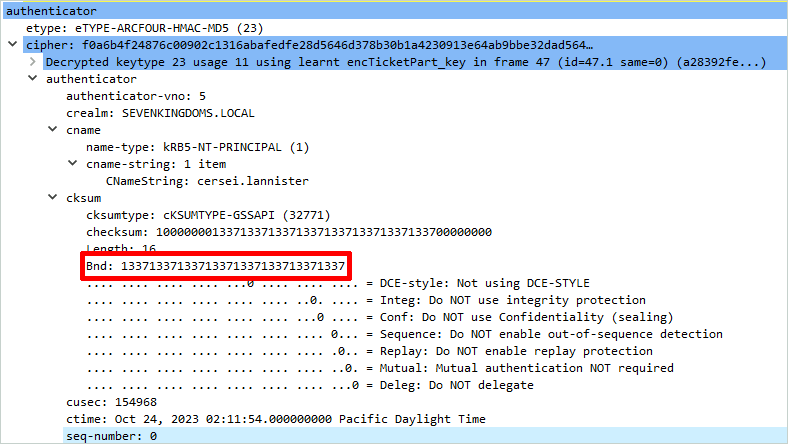
Summary
| LDAP | LDAPS | LDAP + Signing | LDAPS + Channel Binding | |
|---|---|---|---|---|
| NTLM (ldap3 vanilla) | ✅ | ✅ | ❌ | ❌ |
| Kerberos (ldap3 vanilla) | ✅ | ✅ | ❌ | ✅ |
| Schannel (ldap3 vanilla) | ✅ (*) | ✅ | N/A | N/A |
| Simple Authentication (ldap3 vanilla) | ✅ | ✅ | ❌ | ✅ |
| DIGEST-MD5 (ldap3 vanilla) | ✅ | ✅ | ✅ (**) | ❌ |
| NTLM (ldap3 patched) | ✅ | ✅ | ✅ | ✅ |
| Kerberos (ldap3 patched) | ✅ | ✅ | ✅ | ✅ |
| GSS-SPNEGO NTLM (impacket.ldap) | ✅ | ✅ | ❌ | ❌ |
| GSS-SPNEGO Kerberos (impacket.ldap) | ✅ | ✅ | ❌ | ✅ |
* Using StartTLS
** Using the option sign
Conclusion
This brief overview of LDAP authentication protocols usable in Active Directory environments shows that client-side support can vary widely depending on the implementation, but can often be "hacked in" when needed. Since a lot of impacket’s examples are based on ldap3, it seems easy to adapt them to work against hardened domain controllers by installing patches (as shown here by snovvcrash). A fork has been created with the 2 PRs to easily use them in tools. Certipy has recently started supporting channel binding and pywerview implements a logic to automatically detect and handle LDAP protections for you (full disclosure: the author is a pywerview maintainer). If patching ldap3 library is not an option, it is still possible to directly patch the tools to circumvent the problem (see here, and here). Lastly, an even more radical approach can be used: tools such as msldap have chosen to reimplement the authentication stack, via asysocks, asyauth or minikerberos.
Credits
The author would like to thank:
- CravateRouge for kickstarting the idea of this blogpost with their pull request.
- Giovanni Cannata and all the contributors to the ldap3 project.
- Forta, SecureAuth, Alberto Solino and all the contributors to the impacket project.
- SkelSec for their tools, sometimes better than the official Microsoft documentation.
- Mayfly / Orange-CyberDefense for the GOAD project, used in the examples.
